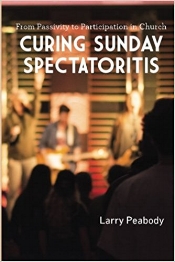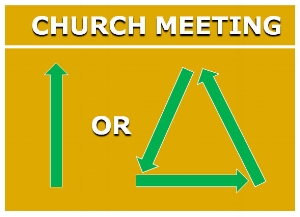Weaving Work-Truth into Church Life (Part Two)
Why so little Sunday talk about weekday work? What’s behind the silence? Part One set the stage for a series on specific ways to bring work-truth into congregational meetings. The first step involves dealing with a viewpoint that can block the work topic from the Sunday agenda. What is this idea that stops such talk?
Visualize your next full-church meeting. What will people see as their purpose for getting together? How does your church leadership explain the reason for gathering? I ask this, because our purpose (or the lack of it) shapes everything we do. If I go into my garage intending to change the oil in my car, I’ll find a wrench and a drain pan. But if I mean to build a bookshelf, I’ll roll out my table saw and some sandpaper. Purpose steers my every action. It’s no different when it comes to church. How we answer the “Why meet?” question determines what does or does not take place on Sundays.
Do We Really Know Why We Should Meet?
As much as churches differ, virtually all seem to agree that the purpose for assembling is . . . to worship. So we have worship services, worship pastors, worship centers, worship teams, worship music, and worship leaders. There’s even worship software! Countless Christians equate worship with the songfest just before the sermon. Others see worship as a feeling of adoration or reverence for God.
If we define worship in those ways, and if we see worship as our purpose for gathering, what will the meeting agenda include? Praise music will fill a good bit of the time. A Bible message that inspires us to exalt God in our hearts, thoughts, and conduct will take most of the remaining minutes. Both good. But any talk about work—that earth-and-money-related thing we do on weekdays—will have a hard time finding its way in. After all, what does work have to do with those conceptions of worship?
But what if this almost-universal idea of why we gather—worship—differs from that which the New Testament teaches? What if worship, while not excluded, is not the main reason to meet with other Christ-followers? Is this farfetched? Some kind of heresy? Plenty of Bible scholars who have studied the New Testament on this subject say otherwise.
The New Testament Perspective on Gathering
In his book, Paul’s Idea of Community, Robert Banks, an Australian theologian and author, says this: “One of the most puzzling features of Paul’s understanding of ekklesia for his contemporaries, whether Jews or Gentiles, must have been his failure to say that a person went to church primarily to ‘worship.’ Not once in all his writings does he suggest that this is the case. Indeed it could not be, for he held a view of ‘worship’ that prevented him from doing so. . . . Since all places and times have now become the venue for worship, Paul cannot speak of Christians assembling in the church distinctively for this purpose.”
The late I. Howard Marshall served as Professor Emeritus of New Testament Exegesis at the University of Aberdeen, Scotland. In his paper, “How Far Did the Early Christians Worship God?” he investigates the “Why gather?” question. After studying the relevant New Testament passages, he wrote: “It is simply not the case that the purpose of Christian meetings was understood as being primarily and directly worship, homage and adoration addressed to God. To speak of a Christian meeting as being ‘a service of worship’ with the implication that everything which takes place must somehow be related directly to this primary purpose is to depart seriously from the NT pattern.”
Why, Then, Should we Gather as Believers?
So—if not worship—what is the New Testament reason for Christians to meet? Banks says: “The purpose of church is the growth and edification [building up] of its members into Christ and into a common life through their God-given ministry to one another.” Marshall agrees: “We are greatly hampered by the one-man ministry which is still so common. Somehow we need to give the individual members of the congregation the opportunity to exercise the gifts of the Spirit, to receive from one another and to show love to one another.”
What Banks and Marshall are saying echoes the purpose of the participatory church meeting Paul describes in I Cor. 14. All that is done should be for “the strengthening of the church” and so that “everyone may be instructed and encouraged.” In Heb. 10:24, 25, the writer—in urging believers not to skip their meetings—tells why they need to gather: so that they may “spur one another on toward love and good works,” and so that they may “encourage one another.”
Strengthening. Instructing. Encouraging. Spurring on. Gathering should be all about one-anothering in love—the very essence of Jesus’ new command in Jn. 13:34. When we discover and adopt the New Testament reason for our meetings, the agenda door will swing open so that work-truth may enter. As pictured in the graphic, we ought to worship in all we do, 24/7—and, yes, when we assemble as well.
Suppose we try to squeeze worship into the weekly meeting with other believers—or (smaller yet) into the time of singing with them? Then our undersized concept of worship will leave no room for something as seemingly “unspiritual” as our daily work. But what if a church structures its meetings to cultivate mutual up-building in all areas of life? What possibilities might that open up for workplace equipping?
Meeting Formats Can Encourage Mutual Up-Building.
In a meeting format that allows it, those with decades of experience in various workplaces can share how God uses them as light and salt there. Those with gifts of teaching can open up the richness of what the Bible says about our everyday work. And newbies to the work world can ask questions that stimulate others to help them prepare for the places to which God will send them to represent his Kingdom during the bulk of their waking hours.
Imagine the dialogue emerging out of that kind of mutual encouragement from the Scriptures and from the testimonies of those seeing God move in the whole lives of fellow Christians. It could cause those present to suck in their breath in awe as they realize what his Spirit is doing through ordinary people in their daily activities, including their work. In this way real—not artificially stimulated—worship would arise from the assembly to the glory of God.
The body of Christ includes a variety of members with diverse callings and gifts. When those members assemble, they must have the opportunity to cross-enrich each other. As Paul puts it in Eph. 4:16, the whole body “grows and builds itself up in love, as each part does its work.” When it understands the New Testament purpose for gathering, the church can aim for each-othering.
A shared-church meeting welcomes all of God’s truth—including his truth about work.






